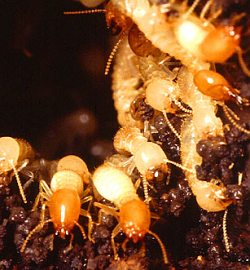Termites (Order: Isoptera)

Subterranean termite workers.
Scott Bauer, USDA
Main characteristics of Termites
Termites are usually small or medium sized, whitish or colourless insects, with short antennae. They have strong biting mouthparts with which to chew seeds, wood or leaves.
Apart from the Hymenoptera (bees, ants and wasps), termites are the only insects that live in social groups. In fact, unlike the Hymenoptera, even the young termite nymphs are active in running the termite community.
Living in a society means having a division of labour. In other words, groups of individuals have particular roles and these groups are known as castes. These are:
- Kings and queens
- Workers
- Soldiers
The king and queen are responsible for reproducing. Whilst the social ants, bees and wasps have a queen, termites have both a queen and a king. They begin life with two pairs of long wings which are of similar size. This is where the name Isoptera comes from - it is made up from the Greek iso, meaning equal and ptera, meaning wings. The wings are delicate and last long enough for the king and queen to fly to find each other, and to establish the nest.
The king plays a continuous part, mating with the queen at regular intervals, whereas in the Hymenoptera the male dies shortly after mating. The queen can have a huge, egg-filled abdomen, up to 10cm long in some species, and lays thousands of eggs each week. In the colonies of the more advanced termite species, it is thought that kings and queens can live for up to 50 years.
But what would happen if the king or the queen died? Among the workers, conveniently, there are wingless, stand-in kings and queens. This is because, unlike the bees, wasps and ants, in which the workers are always sterile females, termite workers can be male or female. They can step in and take over if anything should happen to the king and queen.
Most termites in a colony are workers. Workers look after the royal couple, tend the young, build and repair the nest and feed the soldiers. This division of labour is more marked in the more advanced species of termite.
The workers often give partially digested food to the king and queen, the young and the soldiers - either regurgitated, or as faecal pellets. They can digest the cellulose in leaves and wood by using bacteria and protozoa in their stomachs. The young receive these micro-organisms in the partly digested food they get from the workers.
Soldiers make up around 5% of the colony, and have guard and defence duties. They are larger than the workers, and some have enlarged heads with a thickened exoskeleton and powerful mandibles for defending the nest. Others can have a curious snout-like extension of the head, and can spray intruders with nasty liquids that incapacitate them.
Worker and soldier termites can live for about 4 years.
Termitaria
Termite nests vary in size from fairly modest ones in decaying wood, to huge, complex ones containing a million individual insects. These huge structures can be found in parts of Africa and Australia, and they look like large standing stones. Some can have their own air conditioning system, involving circulated air and vents, to keep the temperature and humidity just right.
Termites and other social insects have a number of tiny creatures of other species that live with them in their nests. These include bristletails and springtails, bugs, moth and fly larvae, centipedes and millipedes. Even colonies of ants have been known to share termite earths. Unless the ants are disturbed, there will be no conflict with the termites.
Termites are important in nature as decomposers and recyclers of tropical and subtropical dead wood. They can become economic pests when they damage homes, cultivated forests and building materials.
Termites are never found more than 50 degrees north of the equator. Of the 3,000 or so species worldwide, only two are found in Europe. These are Kalotermes flavicollis, which lives in dead trees, and Reticulitermes lucifugus, a slightly more advanced species with a more distinct worker caste. This species can nest in trees, shrubs and buildings, and therefore it can cause damage to property.
Classification
There are around 3,000 species in seven families. They show incomplete metamorphosis. Recent research (Inward, Beccaloni & Eggleton, 2007) has shown that Termites are actually a lineage of cockroaches and not a separate insect Order as previously thought. The Order Isoptera is now redundant with the termites now classified as Termitidae and forming part of the Blattodea.
This site will continue to list the Isoptera as a separate Order for the time being so as to remain analogous with most current publications. However, it is likely that this page will be updated to represent the change in the classification in the near future.
How to find them
Termites that feed on dead wood, including the European species, can be found by digging into old logs.
A to Z of insects
- Alderflies
- Ants
- Antlions
- Archaeognatha
- Barklice
- Bees
- Beetles
- Biting lice
- Booklice
- Butterflies
- Bugs
- Caddisflies
- Cockroaches
- Crickets
- Damselflies
- Dobsonflies
- Dragonflies
- Earwigs
- Fleas
- Flies
- Grasshoppers
- Lacewings
- Leaf insects
- Lice
- Mantids
- Mayflies
- Moths
- Praying Mantids
- Scorpionflies
- Snakeflies
- Stick insects
- Stoneflies
- Strepsipterans
- Sucking lice
- Termites
- Three-pronged bristletails
- Thrips
- True Bugs
- Wasps
- Web-spinners
- Zorapterans
- Non-insect hexapods
- Proturans
- Springtails
- Two-pronged bristletails
Back to Insect Orders.
![Amateur Entomologists' Society home page [Logo]](/images/aes-logo-wplant.gif)